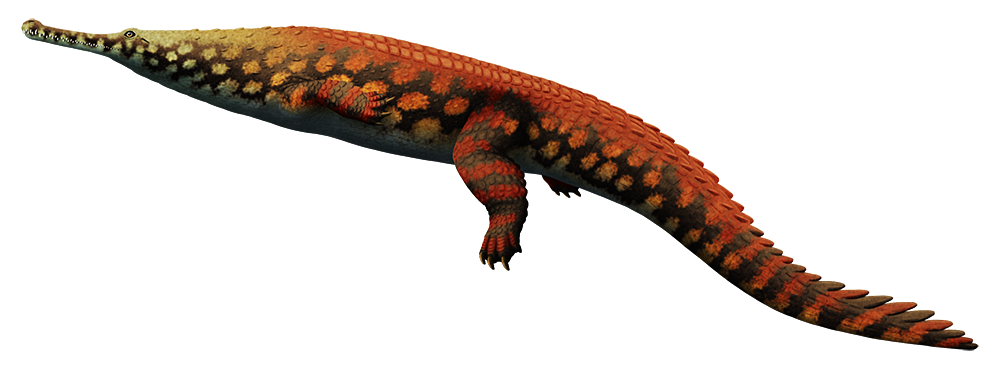First appearing in the Middle Jurassic, about 175 million years ago, the tethysuchians were a group of neosuchian crocodilians – part of the same lineage that includes all living crocs, although they were probably more closely related to the highly marine thalattosuchians than to modern forms.
Their fossil remains have been found almost globally, except for in Antarctica and Australia, and they appear to have been highly aquatic animals living in both freshwater and marine environments. Most members of the group had very long and slender gharial-like snouts, indicating they were specialized for fish-eating, but some (like the enormous Sarcosuchus) developed broader or shorter snout shapes that suggest more generalized diets of whatever they could catch.
One lineage of tethysuchians known as the dyrosaurids evolved around the mid-Cretaceous (~100-90 mya) and quickly spread around most of the world. These crocs mainly inhabited coastal marine waters, with a few species also living full-time in estuaries or rivers.
They had tall vertebrae around their shoulders, giving them a slightly hump-backed appearance and anchoring large neck muscles that allowed them to quickly whip their jaws around to catch fast-moving fish. Their deep vertically-flattened tails were capable of an even more powerful swimming stroke than those of modern crocs, and their well-muscled limbs probably made them strong walkers when on land.
The dyrosaurids were some of the few marine reptiles to survive through the end-Cretaceous extinction (~66 mya) relatively unscathed, and several species are known from both sides of the K-Pg boundary. This may be because the marine dyrosaurids are thought to have seasonally migrated inland to breed in freshwater environments, with juveniles spending their early lives in rivers and only returning to the coasts as adults – and since freshwater ecosystems were much less affected by the mass extinction than marine ones, this allowed them to continue on while groups like the mosasaurs and plesiosaurs died out.
Dyrosaurus maghribensis here lived during the Late Paleocene and Early Eocene of Morocco (~56-48 mya). It was similar in size to the largest living crocs, around 6m long (19′8″), but had thinner and less extensive bony osteoderm armor.
During the Eocene the dyrosaurids began to disappear, and by the Late Eocene (~37 mya) the last known species were found only in northern Africa. It’s not entirely clear why these once-successful tethysuchians began to decline, but they may have been struggling to deal with the cooling climate trends at the time. If they managed to persist until the end of the Eocene, sudden temperature and sea level drops during the Eocene-Oligocene extinction (~33 mya) probably finished them off entirely.


